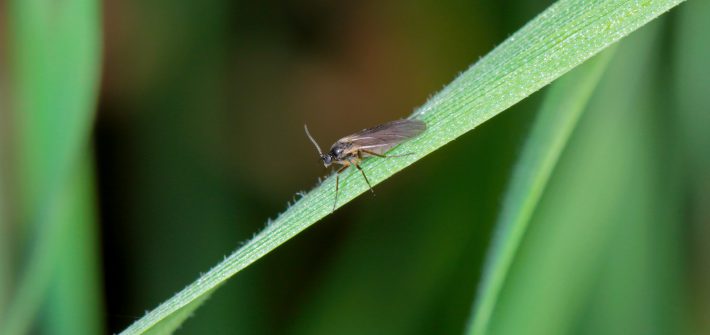Tips from an ecologist
Fungus Gnats: A Common Pest
Houseplants harbor any number of animals on the plant itself or in the soil. I received an unpleasant surprise by way of a philodendron on a north-facing windowsill outside my office. After many years, there came an outpouring of small black flies that mostly hung around the pot but also explored the conference table nearby. I had to move the plant down the hall to spare my colleagues the too-frequent approaches of these tiny explorers.
These flies belonged to one of the many species of fungus gnats, probably a dark-winged fungus gnat (family Sciaridae), and after a while, their numbers subsided. Several months later, in the new location, they appeared again, but the people now in charge of watering the pot solved the problem by simply forgetting to water it. The plant died and that was that.
The Life of the Fungus Gnat
The larval gnats are quite small and, as the name implies, feed on the fungi that inevitably grow in the pots of houseplants. Yes, there are many kinds of fungi in normal, healthy soil, and you should welcome them. Root fungi (mycorrhizae) can help plants absorb water and nutrients. Others decompose the organic matter in the soil, releasing inorganic nutrients that your plants need. Some consume bacteria and other fungi (it’s a tough life among the decomposers), while a few attack tiny soil animals. And there are still others doing things we don’t understand. Fungi tend to grow in thread-like strands of cells called hyphae, and the gnat larvae are the right size to feed on fungal hyphae. If a female gnat lays eggs in a pot of soil, the larvae all hatch from their eggs at about the same time, feed on the fungi at essentially the same rate, and mature nearly simultaneously, leading to an emergence of adults that appears to come out of nowhere. Then it’s breed, cycle, repeat.
While there are a few species of fungus gnats that attack and damage plants, these are unlikely to be the ones emerging from a typical pot.
The gnats can be annoying, as were the ones in my plant. Any normal person would prefer not to have them flying around our homes, faces and food. According to Wikipedia (the font of all knowledge) they can be controlled by adding a biological control agent, the nematode Steinernema feltiae. These roundworms parasitize the immature stages of many kinds of flies in the soil, including the larvae and pupae of fungus gnats. I’ve never tried to apply nematodes for this problem, but there are several vendors willing to sell them to you for a range of prices. You might want to check the information about these worms from Dr. Anthony Shelton at Cornell University’s College of Agriculture and Life Sciences, where entomologists have been studying insect control for many decades.
Be sure to get the right kind of nematode. Some will attack plants, pets, or even people. But nematode parasites tend to be host specific, and S. feltiae attacks only flies. Plant supply stores will provide the correct variety.
What About Fruit Flies?
Sometimes we see some small flies in our houses that look like miniature houseflies, but are tan instead of black. These are fruit flies, or more properly, pomace flies or small fruit flies, members of the family Drosophilidae (entomologists reserve the name fruit flies for the family Tephritidae, which includes some major plant pests like the Mediterranean fruit fly). The fruit flies that show up in our houses are not emerging from your plant pots, but are instead investigating any fruit (especially overripe fruit, including tomatoes) as a possible place to lay their eggs. Their larvae love fruit pulp, and will mature in about two weeks.
Pomace flies are not harming your plants, and will land on leaves and stems only incidentally. They might take nectar from flowers, but they won’t stay too long. Small flies tend to be annoying, but they are not coming from your pots. They are either strays hoping to find something good, or they have already found what they want in your kitchen. Leaving fruit in the open will attract fruit flies. Storing it in airtight containers can thwart fruit flies.
One last thing: fruit flies do like alcohol and will seek out a glass with any amount of alcoholic beverage in it. The flies drown quickly, but you might not want to have even dead flies as a garnish.
Owen Sholes is a retired professor of ecology and author of the book “Stopping By Woods: Robert Frost as New England Naturalist”.
